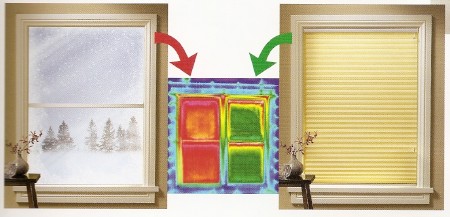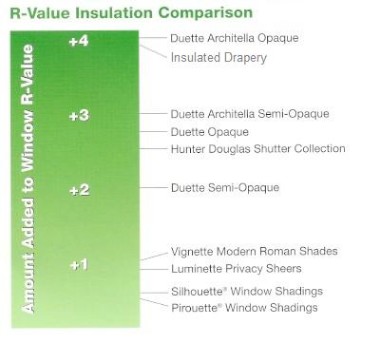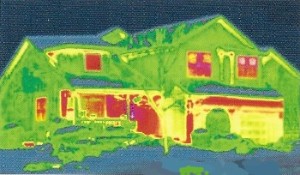| R-Value |
R-Value or "Resistance Value" is the measure of thermal resistance or heat loss as used in the building and construction industry. The bigger the number, the better the building's insulation effectiveness. The walls of a contemporary home typically have an R-Value of 19, attics and roofs around 30, while standard double-pane windows only have an R-Value of about 2.
Windows are Energy Holes
Windows were once called "wind holes". Fortunately, today's seasled double-pane windows do a good job of preventing unwanted air flow. However, closed windows sitll offer very little resistance to the flow of heat passing through them. Window are, in fact, "energy holes". Compared to well insulated walls and roofs of modern homes, standard double-pane windows allow 10 to 15 times more heat energy to flow through them. So, despite the fact that windows make up only about 10% of a home's insulated shell, up to 50% of the home's heating and cooling energy pours through them. This means that up to half of what is paid for heating and cooling utility bills pours through them as well.
How much heat loss can you afford?
|
Heat flow through windows i |
Window Coverings Insulate Windows
 |
 Hunter Douglas Duette Architella with R-value of 4 shown on window. |
| The infrared photo (center-left) shows heat loss pouring through the uncovered window by its red color. By adding a window covering to the window, heat loss is drastically reduced as the green color indicates. | |
Other Insulating Product Choices
| If you live in a climate with significant heating required for more than half the year, you should select a window covering that adds at least one point of R-Value to your window (the more the better). When a product is chosen for its insulating qualities, it is best to fit the shade or blind fully recessed inside the window casement to minimize the escaping cold air. If mounting outside the window, such as with drapery, be sure to tack down the return ends to the wall to hold the drapery tightly to the wall. |  |
Energy Saving Tips for Winter and Summer
Open and close your window treatments to take advantage of natural warmth (Solar Heat Gain). The basic rule is that when outside temperatures are colder, open window treatments during the day and close them at night. The reverse applies to hot climates where the larger concern is keeping cool air inside--close window treatments during the day and open them at night where privacy is not a concern. This will also protect fabrics and furnishings from fading in strong sunlight.
- South Windows
Open your window treatments for the best hours of sunshine. These windows gain more heat during the daylight hours. - East and West WIndows
Open the window treatments for the three best hours of sunshine. Solar heat is gained through east windows during morning hours and west windows in late afternoon. - North WIndows
Open window treatments for sun in the morning or evening. For the most part, north facing windows receive no direct sunlight and lose more heat than they gain.
Helpful Links:
The U.S. Department of Energy
Daylighting
Window Treatments
Energy Performance Ratings for Windows, Skylight, Doors







 s graphically shown in the infrared photo at right, where red areas indicate energy loss. The dramatic color difference between the walls and windows shows the contrast in resistance to heat flow. By installing energy effcient window treatments, heating and cooling bills can be reduced as much as 40%.
s graphically shown in the infrared photo at right, where red areas indicate energy loss. The dramatic color difference between the walls and windows shows the contrast in resistance to heat flow. By installing energy effcient window treatments, heating and cooling bills can be reduced as much as 40%. 